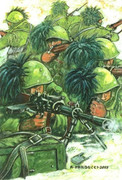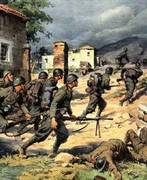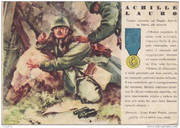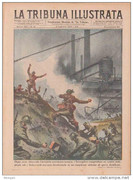04.04.1941 L'3 aprile due plotoni motociclisti dell'8° Reggimento Bersaglieri e Divisione di Fanteria 'Sabratha' precedettero l'ingresso delle colonne tedesche a Benghazi in Nord Africa: l'operazione ideata dal colonnello Gino Fabris fu soprattutto un successo politico e propagandistico. Poco dopo giunsero a Benghazi gli altri reparti dell'3° Battaglione Esploratori Tedesco e i carri , completando così l'occupazione della città.
Video13.04.1941 Durante tutta la notte del 13 e il mattino del 14 aprile, i reparti italiani in Albania dovettero difendersi dai ripetuti attacchi della divisione 'Jadranska'.
"For 48 hours the Serbs have been moving in wave upon wave through rain and snow against Scutari, on the southern shore of a lake of the same name, only to be mowed down by Fascist machine-gunners and scattered by Italian airmen, war front advices said. https://news.google.com/newspapers?nid=191...4,5315859&hl=en (Serb Attacks Beaten Off By Italians, Schenectady Gazette, 15 April 1941)

(
www.pinterest.com/search/pins/?q=b...rsaglieri%typed Pinterest)
16.04.1941 Il 16 aprile 1941, Il 4 ° Reggimento Bersaglieri entrarono a Koritza in Albania,
costringendo al ritiro l'esercito britannico in Grecia.
"
Their courage, like that of the defenders of the Metaxas line, was to no avail; as so often happens to troops occupying a static position in mobile warfare, the battle was being decided elsewhere … List now detached SS ‘Adolf Hitler’ from the main axis of advance of XXXXth corps and sent it forward in the direction of Koritsa. Far from counter-attacking, however, the demoralized Greeks gave way and thus allowed the Italians to occupy the town without resistance on 15 April. With 9th armoured division crossing the upper Aliakhmon and reaching Servia on the next day, the British forces on the Olympus found themselves surrounded on both flanks. following a decision made by Wilson three days earlier they now started falling back across Thessaly to Thermopylae, leaving in their wake 20,000 Greek troops who, being less well endowed with motor vehicles, failed to escape in time and were captured by the Germans." (Martin van Crevald, Hitler’s Strategy 1940-1941: The Balkan Clue, p. 162, Cambridge University Press, 1973)
"
About 25 miles south of Lake Ochrid, Koritza is a road junction whence a road leads eastwards to Florina, hinge of the present British-Greek line confronting the Axis armies. Fast columns of Bersaglieri on motor cycles and in armored cars entered Koritza at 12.30 p.m. today and captured "numerous prisoners and arms of every kind including several batteries of cannon," it was claimed. (
https://news.google.com/newspapers?nid=194...6,2463178&hl=en KORITZA TAKEN ITALIANS CLAIM Recapture of Important Albanian Town Announced at Rome, The Montreal Gazette, April 15, 1941)

(
www.romanoguerra.it/corriere_1939_45.php Domeniche del Corriere)
18.04.1941 Dopo aver raggiunto gli obiettivi in Albania della Linea Difensiva Greca (Argirocastro e Permeti) stabilita con il comando germanico, le truppe della 11a Armata Italiana ('Brennero', 'Julia' e 'Modena') iniziarono a spingersi lungo la costa ionica, per continuare a coprire il fianco destro dell'offensiva germanica in grecia.
"Under the umbrella of air supremacy, tens of thousands of troops from the Brennero, Julia and Modena Divisions were able to advance along roads stretching from Argirocastro to Libonovo and Delvine, in concert with the Bari and Taro Divisions now racing to reach Ponte Perati." (
www.comandosupremo.com/ponte-perati...a.html#comments Ponte Perati: The ‘Highway of Death’ of the Greek Army in Albania)
22.04.1941 Dopo aver perso il controllo di tutti gli avamposti avanzati, la guarnigione greca di Ponte Perati (50.000 uomini) si arrese alle forze italiane.
"By nightfall, the division, bloodied, but undaunted, could say with pride it had broken the back of a stout enemy. The Bari Division, which had borne a great deal of the Ponte Perati action, was to report the loss of 30 officers and 400 other ranks, killed or wounded." (
www.comandosupremo.com/ponte-perati...in-albania.html Ponte Perati: The ‘Highway of Death’ of the Greek Army in Albania)
QUOTE
"Al ponte di Perati, sul fronte greco, il maggiore Lauro, dopo che il colonnello era stato ferito, assunse il comando del 130° reggimento di fanteria e, ferito due volte, rifiutò di ritirarsi, finché, colpito una terza volta, cadde alla testa."
(Napoli nella Seconda Guerra Mondiale, pag. 110, Istituto di Studi Storici Economici e Sociali, 2006)

(
"The Commanding Officer of the 139th Infantry Regiment (Bari Division), Lieutenant-Colonel Achille Lauro, was killed and awarded the Medaglia d’Oro al Valor Militare for his outstanding leadership in the face of the fierce enemy fire".
www.comandosupremo.com/ponte-perati...in-albania.html Ponte Perati: The ‘Highway of Death’ of the Greek Army in Albania)
20.10.1941 Il 20 ottobre 1941, il 20° Battaglione Bersaglieri della Divisione 'Pasubio' dopo aver ottenuto la resa della stazione ferroviaria di Stalino, si spinsero velocemente verso le posizioni tenute dalla 383° Divisione di Fanteria Sovietica, costringendo il nemico alla fuga.
"
The situations for the Soviets became very serious on the northern flank of the 383rd Rifle Division, around the suburban railroad station of Stantsia Stalino, where the Italians were advancing. With the capture of Grishino and Grodovska from the 296th Rifle Division the Pasubio Division had maneuvered to the north of the Celere Division, thus securing the left flank of the Bersaglieri and cavalrymen. General Marazzini decided it was an opportune time to attack the 383rd Rifle Division's unprotected flank, in the viciniity of Yasinovataya. A reinforced battalion from the 291st Rifle Regiment, under 1st Lieutenant Shcherbak, was sent to the threatened area. The Soviet battalion fought bitterly to prevent an Italian breakthrough and delayed them long enought to allow the "Miners" Division to retreat. Nevertheless, the XX Bersaglieri Battalion captured Stalino Station. Threatened by the Italians to the north, and with Germans vanguards already in Stalino, the Russians had no choice but to abandon the city." (Regio Esercito: The Italian Royal Army in Mussolini's Wars, 1935-1943, Patrick Cloutier, p. 67, Lulu Press, 2010

(
www.delcampe.net/page/item/id,31214...language,E.html Tribuna Illustrata 31 1942 - Guerra,Fronte RUsso,Bersaglieri - Africa,Nostro Settotenente Medico,Medaglia d'Oro)
29.06.1942 Le Divisioni 'Brescia', 'Trento' e 'Littorio', sostenuto da due battaglione del 7º Reggimento bersaglieri, ebbero un ruolo decisivo nella Battaglia di Marsa Matruh e Fuka in Nord Africa, nella quale vennero catturatio 10.000 soldadi alleati.
(
"Italian combat sappers cleared gaps in the minefields slowly because of heavy artillery fire, and at dawn supporting infantry moved up. Colonel Ugo Scirocco’s 7th Bersaglieri Regiment finally broke into the British defenses, and at 0930 hours, the 6000 remnants of the Xth British Corps, were captured along with large quantities of supplies. About the same time, the 21st Panzer Division intercepted another British column retreating to the east, capturing another 1,600." www.comandosupremo.com/mersa.html/2 The Battle of Mersa Matruh)
VideoEdited by johnpasino - 23/3/2016, 12:31



